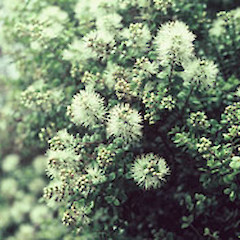Metrosideros perforata
Common name
akatea
Synonyms
Leptospermum perforatum J.R.Forst. et G.Forst., Metrosideros scandens Sol. ex Gaertn.
Family
Myrtaceae
Flora category
Vascular – Native
Endemic taxon
Yes
Endemic genus
No
Endemic family
No
Structural class
Lianes & Related Trailing Plants - Dicotyledons
NVS code
The National Vegetation Survey (NVS) Databank is a physical archive and electronic databank containing records of over 94,000 vegetation survey plots - including data from over 19,000 permanent plots. NVS maintains a standard set of species code abbreviations that correspond to standard scientific plant names from the Ngä Tipu o Aotearoa - New Zealand Plants database.
METPER
Chromosome number
2n = 22
Current conservation status
The conservation status of all known New Zealand vascular plant taxa at the rank of species and below were reassessed in 2017 using the New Zealand Threat Classification System (NZTCS) – more information about this can be found on the NZTCS website. This report includes a statistical summary and brief notes on changes since 2012 and replaces all previous NZTCS lists for vascular plants.
Please note, threat classifications are often suggested by authors when publications fall between NZTCS assessment periods – an interim threat classification status has not been assessed by the NZTCS panel.
- Conservation status of New Zealand indigenous vascular plants, 2017 . 2018. Peter J. de Lange, Jeremy R. Rolfe, John W. Barkla, Shannel P. Courtney, Paul D. Champion, Leon R. Perrie, Sarah M. Beadel, Kerry A. Ford, Ilse Breitwieser, Ines Schönberger, Rowan Hindmarsh-Walls, Peter B. Heenan and Kate Ladley. Department of Conservation. Source: NZTCS and licensed by DOC for reuse under the Creative Commons Attribution 4.0 International licence.
2017 | Threatened – Nationally Vulnerable | Qualifiers: DP, De
Previous conservation statuses
2012 | Not Threatened
2009 | Not Threatened
2004 | Not Threatened
Brief description
Woody long-climbing vine. Mature plants only reproductive. Leaves more or less circular, dark green above, pale green below, both surfaces covered in fine glandular spots (especially evident on leaf undersides). Flowers white (rarely pink) in dense, terminal, fluffy, clusters.
Distribution
Endemic. New Zealand: Manawatāwhi / Three Kings Islands, North Island, South Island (to about northern Otago and northern Fiordland).
Habitat
Coastal to montane. An abundant plant of open scrub, dense forest or rock-land. In forest and scrub situations climbing on other trees but also climbing up cliff faces, on rock outcrops, and forming a “shrubland” in loose talus
Wetland plant indicator status rating
Information derived from the revised national wetland plant list prepared to assist councils in delineating and monitoring wetlands (Clarkson et al., 2021 Manaaki Whenua – Landcare Research Contract Report LC3975 for Hawke’s Bay Regional Council). The national plant list categorises plants by the extent to which they are found in wetlands and not ‘drylands’. The indicator status ratings are OBL (obligate wetland), FACW (facultative wetland), FAC (facultative), FACU (facultative upland), and UPL (obligate upland). If you have suggestions for the Wetland Indicator Status Rating, please contact: [Enable JavaScript to view protected content]
FACU: Facultative Upland
Occasionally is a hydrophyte but usually occurs in uplands (non-wetlands).
Detailed description
Vine up to 20 m (rarely more long). Growth dimorphic, juvenile and climbing vines sparingly branched, mature (adult reproductive state) heavily branched. Bark furrowed, dark grey to brown-black, ± tessellated, and flaking in tabular shards. Branchlets terete, ± invested in short dark brown setose hairs. Leaves close-set, coriaceous, glandular punctate (this especially evident on abaxial surface) subsessile; petioles 1.0–3.2 mm long, lamina 6–12 × 5–9 mm, broad-ovate, broad-oblong to suborbicular, obtuse, adaxially dark green, ± glabrous, abaxially very pale green; finely setose; margins recurved. Inflorescences in axillary few-flowered cymose botryia, these crowded towards apex of branchlets; peduncles and pedicels pubescent to setose; peduncles 10–40 mm long, pedicels 5–10 mm. Hypanthium broad-turbinate, initially fleshy, finely tomentose ± glabrescent; calyx lobes broadly deltoid, obtuse; petals caducous, 1.5–3.0 × 1.5–2.8 mm, suborbicular, white or pink; stamens numerous, 8–10 mm long, white (rarely pink). Capsule 4–5 mm diameter, 3-valved, subglobose, exserted, ± woody.
Manaaki Whenua Online Interactive Key
Similar taxa
Easily distinguished from all other indigenous Metrosideros by the small rounded “spotted” (glandular-punctate) leaves, which are dark green above and pale green below (the spotting is most evident on the leaf undersides), and by the dense clusters of white flowers. In its juvenile state it may be confused with juvenile vines of Metrosideros carminea. However, the young growth of Metrosideros carminea is distinctly pinkish and the leaf hairs are much longer and pink coloured. Despite the common name “white rata” Metrosideros perforata is not closely related to Metrosideros albiflora, which is a species virtually confined to northern New Zealand kauri (Agathis australis) forest, and which has much larger leaves (without obvious glandular spotting) and fewer, larger inflorescences.
Flowering
November–March
Flower colours
White
Fruiting
February–May
Propagation technique
Easily grown from rooted pieces. Can be grown from semi-hardwood cuttings. However like all Metrosideros cuttings can be fickle to strike. A tough, resilient rata suitable for open situations and once established tolerant of drought and moderate frost.
Threats
When myrtle rust (Austropuccinia psidii) was detected in New Zealand (May 2017) the conservation status was upgraded as a precautionary measure to ‘Threatened – Nationally Vulnerable’ because, on best advice, it was believed that no indigenous Myrtaceae had resistance to the myrtle rust disease (de Lange et al. 2018).
Myrtle rust (Austropuccinia psidii) is an invasive fungus that threatens native myrtle species. Learn more myrtlerust.org.nz.
Etymology
metrosideros: Iron heart
perforata: From the Latin perforatus ‘pierced with holes’, depending on the species this may refer to the foliage covered in punctate oil glands
Attribution
Fact sheet prepared for NZPCN by P.J. de Lange (5 January 2013). Description based on fresh material.
NZPCN Fact Sheet citation
Please cite as: de Lange, P.J. (Year at time of access): Metrosideros perforata Fact Sheet (content continuously updated). New Zealand Plant Conservation Network. https://www.nzpcn.org.nz/flora/species/metrosideros-perforata/ (Date website was queried)

























